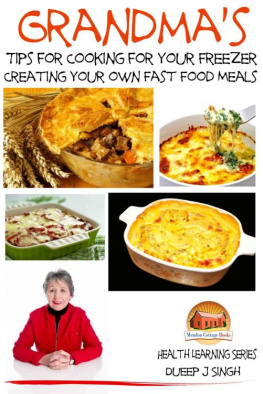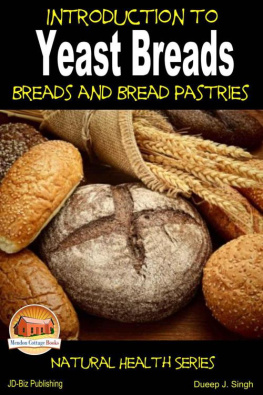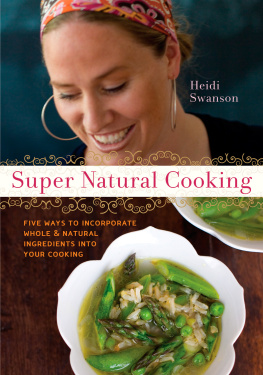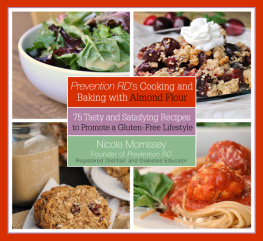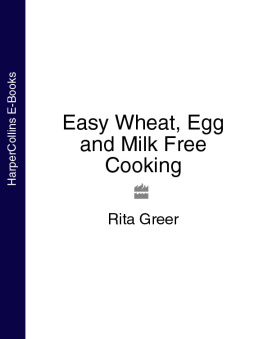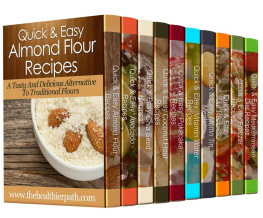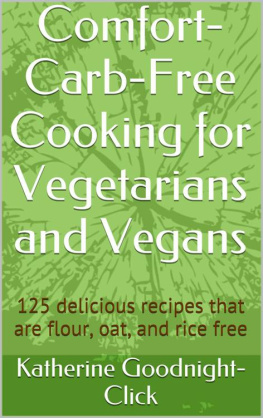Singh Dueep J - Cooking with Flour: Healthy Eating with Flour Recipes
Here you can read online Singh Dueep J - Cooking with Flour: Healthy Eating with Flour Recipes full text of the book (entire story) in english for free. Download pdf and epub, get meaning, cover and reviews about this ebook. year: 2014, publisher: JD-Biz Corp Publishing, genre: Home and family. Description of the work, (preface) as well as reviews are available. Best literature library LitArk.com created for fans of good reading and offers a wide selection of genres:
Romance novel
Science fiction
Adventure
Detective
Science
History
Home and family
Prose
Art
Politics
Computer
Non-fiction
Religion
Business
Children
Humor
Choose a favorite category and find really read worthwhile books. Enjoy immersion in the world of imagination, feel the emotions of the characters or learn something new for yourself, make an fascinating discovery.
- Book:Cooking with Flour: Healthy Eating with Flour Recipes
- Author:
- Publisher:JD-Biz Corp Publishing
- Genre:
- Year:2014
- Rating:4 / 5
- Favourites:Add to favourites
- Your mark:
- 80
- 1
- 2
- 3
- 4
- 5
Cooking with Flour: Healthy Eating with Flour Recipes: summary, description and annotation
We offer to read an annotation, description, summary or preface (depends on what the author of the book "Cooking with Flour: Healthy Eating with Flour Recipes" wrote himself). If you haven't found the necessary information about the book — write in the comments, we will try to find it.
Cooking with Flour: Healthy Eating with Flour Recipes — read online for free the complete book (whole text) full work
Below is the text of the book, divided by pages. System saving the place of the last page read, allows you to conveniently read the book "Cooking with Flour: Healthy Eating with Flour Recipes" online for free, without having to search again every time where you left off. Put a bookmark, and you can go to the page where you finished reading at any time.
Font size:
Interval:
Bookmark:
Cooking with Flour
Healthy Eating with Flour Recipes

Healthy Cooking Series
Dueep J. Singh
Mendon Cottage Books

JD-Biz Publishing
All Rights Reserved.
No part of this publication may be reproduced in any form or by any means, including scanning, photocopying, or otherwise without prior written permission from JD-Biz Corp Copyright 2014
All Images Licensed by Fotolia and 123RF.
Disclaimer
The information is this book is provided for informational purposes only. It is not intended to be used and medical advice or a substitute for proper medical treatment by a qualified health care provider. The information is believed to be accurate as presented based on research by the author.
The contents have not been evaluated by the U.S. Food and Drug Administration or any other Government or Health Organization and the contents in this book are not to be used to treat cure or prevent disease.
The author or publisher is not responsible for the use or safety of any diet, procedure or treatment mentioned in this book. The author or publisher is not responsible for errors or omissions that may exist.
Warning
The Book is for informational purposes only and before taking on any diet, treatment or medical procedure, it is recommended to consult with your primary health care provider.
Check out some of the other Healthy Gardening Series books at Amazon.com
Gardening Series on Amazon
Check out some of the other Health Learning Series books at Amazon.com
Health Learning Series on Amazon
Table of Contents
A couple of months ago I wrote a natural health series book on cooking with wheat berries. Here is an introduction to one of the basic natural ingredients which is used extensively in cooking, but we overlook it so often, because we are so used to it.
Just imagine a life without bread, pastries, cakes, doughnuts, waffles, muffins, griddle cakes and other such delicious items. If we enjoy baking, the first ingredient which we are going to collect in our recipe list is going to be flour.
Nobody knows when cereals and grasses began to be used as flour, by mankind. Until then, he used to make his bread by making up a pounded paste of roots, bark and seeds, flattening it, and then cooking it on hot stones. As his tastes began to grow more and more sophisticated he found out that it was very easy to grow and then harvest cereals, and then grind them into a powder. This is the powder, which we hold so precious and, which we call Flour.
Many of the ingredients that we see now in baking recipes call for all-purpose flour. This is made from hard spring wheat. It is high in protein and it is normally used to replace highly refined pastry flour
Pastry flour is made from soft wheat and it gives a lighter texture to fragile baked products like small cakes, biscuits and pastries.
A Baker normally chooses the all-purpose flour for yeast dough, sauce thickening and strudels. In the same manner, cake flour is also a different type of flour. It is a soft wheat flour and is of very fine grain. It is velvety soft, when you handle it. It is perfectly white. However its protein value is very low.
But millenniums ago, people did not know much about all-purpose flours. They just knew that they could use buckwheat, rice, soybean, rye, potato, split peas, lentils, maize and cornmeal as the basis of a large number of flours. So, depending on the place where you live, you are going to get either refined white flour or whole wheat flour.
This is the flour, which is normally used when there is no question of adding yeast. This is available in the market with salt and raising agents already added to it. This white flour has uncountable general uses and you can make it very easily by converting plain flour to self-raising.
Here is the traditional method of self-raising white flour. Take 28 cupfuls of ordinary white flour. This is going to be 7 pounds. To this, you are going to add 1 pound of baking powder, and 1 ounce of salt.
All-purpose flour is normally used by those people, who want a self-rising flour religious predictable and easy to handle. This is normally used in making light cakes and pastries. However, plain flour is the preferred flour used for puddings, Madeira cake, sponge cake, batters, quick breads, and yeast doughs.
This is the traditional way in which traditional bakers made their baking powder. They mix 3 ounces of Tartaric acid powder with 4 ounces of bicarbonate of soda. This was then placed in dry containers and stored in a dry storage place. I found this recipe modified in the East, where our Baker, who does not bother about mass-produced baking powder, and made his own with bicarbonate of soda and tartaric acid, added 4 ounces of ground rice flour. He said this absorbed moisture and save the mixture from becoming lumpy.
There is another traditional alternating method in which you can make baking powder. This is to combine cream of tartar with half its weight of white carbonate of soda with or without their combined weight of ground rice. This is perhaps the better of the two methods I have given you as in certain combinations, the first may give a slight hint of bitterness, especially because of the tartaric acid.
If you look in the market and are confused by a baking powder box which says double action baking powder, well, here is the difference between single action baking powder and double acting baking powder
Single action baking powder normally uses tartaric acid or cream of tartar tartrate baking powder. If it uses calcium phosphate, it is going to be a phosphate baking powder
A double acting baking powder is going to have 2 acid ingredients. It is called double acting, because part of rising or leavening action is going to take place with the cold, moist ingredients and the rest is going to take place when the dough is in the oven.
Graham flour is normally used in Canada for making yeast rolls and loafs, quick breads, and also cakes. This is nothing but whole wheat flour from which the wheat kernel and the wheat bran has not been removed. This was a very popular and healthy wheat flour eaten extensively in Canada in the 60s, and in the US, it is now marketed as a coarsely ground whole wheat flour, which is stone ground.
Funnily enough, I have never come across many cookery recipes in the West, calling for Graham flour. That is because a substitute is used by using 1 cup of whole wheat flour and 1 cup of bran.
Graham flour is not white flour it is brownish in color, because it has not been refined, and the bran has not been removed. Normally, Graham flours, which are made for making quick breads loaves and rolls are mixed with white flour so as to get the best of both worlds.
The whole wheat flour is going to provide all the protein. The bran content is going to give you a natural| but it is going to leave less room for gluten, which makes for lightness in the bread. That is why the white flour, which is rich in gluten is mixed with the brown flour to avoid a heavy loaf.
Rye flour has been in use for millenniums, especially in the Middle Eastern countries and in African countries to give a really weighty bread the early evening agent is going to find small quantities of gluten to work with. That is why the rye loaves are apt to be shape less. They are also going to be heavy textured and dark in color.
Font size:
Interval:
Bookmark:
Similar books «Cooking with Flour: Healthy Eating with Flour Recipes»
Look at similar books to Cooking with Flour: Healthy Eating with Flour Recipes. We have selected literature similar in name and meaning in the hope of providing readers with more options to find new, interesting, not yet read works.
Discussion, reviews of the book Cooking with Flour: Healthy Eating with Flour Recipes and just readers' own opinions. Leave your comments, write what you think about the work, its meaning or the main characters. Specify what exactly you liked and what you didn't like, and why you think so.



